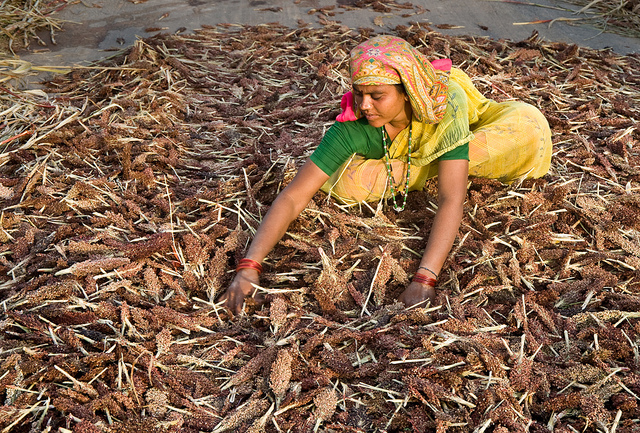
Drying Sorghum Panicles, ICRISAT
During the course of my research it became apparent that the overriding cause of food loss in developing nations is the general inefficiency and lack of resources available to farmers throughout the supply chain, particularly during the post-harvest stages. This is evident in Sub
Saharan Africa. Unfortunately, inadequate investment in technology and infrastructure is commonplace in the region (Atanda, Pessu, Agoda, Isong, & Ikotun, 2011; Lundqvist, Fraiture, & Molden, 2008). A lack of adequate storage, drying, processing, refrigeration and transportation facilities have all been cited as crucial shortcomings that cause excessive losses. For example, the method of drying shown in the image above could lead to losses. Open drying exposes the produce to pests and the elements, which in turn could lead to quantitative losses or mould formation and subsequent formation of mycotoxins, rendering the food inedible.
Take storage for instance. Some estimates figure that up to 40% of losses in developing countries are the result of storage facilities that were not fit for purpose (Fox & Fimeche, 2013). Solutions like the small metal silos advocated by FAO (2008) can undoubtedly reduce the amount of food that gets lost. Similar interventions in storage and indeed in processing (e.g. dryers), refrigeration and transport would undoubtedly offer further improvements. However, the issue of food loss needs to be viewed from a wider lens. The inadequacy of the entire food chain must be considered.
Although a key contributor to food loss, underdeveloped post-harvest systems are by no means the exclusive cause of losses in Sub Saharan Africa. Inadequate marketing chains and crop production choices and techniques are also important factors (Gustavsson, J., Cederberg, C., Sonesson, U., Van Otterdijk, R., & Meybeck, 2011). These steps in the value chain must be fortified or efforts made at the post-harvest stage would be in vain.
For instance, storage and refrigeration interventions can reduce the levels of losses experienced by farmers, resulting in more produce being available to send to the processor. However, if processing facilities cannot cope with the increased workload the fruit will likely be lost. This situation regularly occurs in Kenya during mango season (Timmermans et al., 2014). In this way, the loss has merely been “pushed “further up the supply chain, and little or no net reduction in food loss has been achieved. Likewise, an increase in produce demands a proper outlet, otherwise a similar scenario to that described above would unfold. Furthermore, interventions must be made at the harvest stage, otherwise efforts at the post-harvest stage would be rendered futile as losses may have already occurred.
It is my strong opinion that investments need to be made to fortify the entire value chain. It is indeed difficult to disagree with the assertion that losses are symptomatic of inefficient value chains (World Bank, 2009), not just ineffective post-harvest processes. While my research focused on post-harvest processes, I have certainly learned that interventions at the post-harvest stage need to be matched by similar interventions at subsequent stages of the supply chain, and indeed at the harvest and pre-harvest stages.
Feel free to comment on this post below.
Further Reading
Atanda, S. A., Pessu, P. O., Agoda, S., Isong, I. U., & Ikotun, I. (2011). The concepts and problems of post–harvest food losses in perishable crops. African Journal of Food Science, 5(11), 603–613.
FAO. (2008). Household metal silos: key allies in FAO’s fight against hunger, 8. Retrieved from http://www.fao.org/fileadmin/user_upload/ags/publications/silos_E_light.pdf
Fox, T., & Fimeche, C. (2013). Global food: waste not, want not. Institute of Mechanical Engineers, London, Jan, 1–14. Retrieved from www.imeche.org\nhttp://scholar.google.com/scholar?hl=en&btnG=Search&q=intitle:Global+Food+-+Waste+not,+want+not.#0
Gustavsson, J., Cederberg, C., Sonesson, U., Van Otterdijk, R., & Meybeck, A. (2011). Global Food Losses Amd Food Waste. Rome: Food and Agriculture Organization of the United Nations.
Lundqvist, J., Fraiture, C. De, & Molden, D. (2008). Saving Water: From Field to Fork Curbing Losses and Wastage in the Food Chain, (May), 5–29.
Timmermans, A. J. M., Ambuko, J., Belik, W., & Huang, J. (2014). Food losses and waste in the context of sustainable food systems (No. 8). CFS Committee on World Food Security HLPE.
World Bank. (2009). Missing Food :The Case of postharvest Grain Losses in Sub-Saharan African. The World Bank, 60371-AFR(60371), 116. http://doi.org/Report No. 60371-AFR
